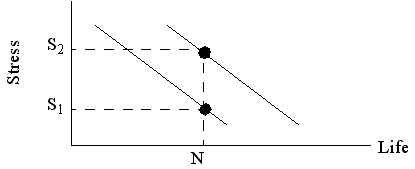XXXXXXXXXXXXXXXXXXXXXXXXXXXXXXXXXXXXXXXXXXXXXXXXXXXXXXXXXXXXXXXXXXXXXXXXXXXXXXXXXXXXXXXXXXXXXXXXXXXXXXXXXXXXXXXXXXXXXXXXXXXXXXXXXXXXXXXXXXXXXXXXXXXXXXXX''"> Component vs. Material S-N Curves
Material (Local) S-N Curves
The S‑N curve relates elastic stress, S, to the number of cycles, N, required to cause failure. Typically, nominal stresses are calculated from equations, derived from elastic theory, which relate applied loading force and geometry to stress. Figure together with equations
(3‑1),
(3‑2) and
(3‑3) illustrate such relationships for a circular bar subjected to axial, torsional and bending loads respectively.
Figure 3‑42 Axial, Torsional, and Bending Loads on Beam
(3‑1)

(3‑2)

(3‑3)

The S‑N curves generated when the stresses calculated from the above equations are plotted against observed cycles to failure are often referred to a material or local elastic S‑N curves since they represent the relationship between nominal stresses at the point of failure in a material to life. Such curves can be used for detecting failure locations and estimating lives across an entire finite element model for which appropriate elastic stresses have been calculated. All else being equal, the failure location(s) will correspond to regions of the model exhibiting the highest stresses. Furthermore, the distribution of expected lives can be usefully represented by a contour plot of life.
Component (Global) S-N Curves
Where stress-life data have been generated by testing complete components or pseudo-components rather than smooth polished bars of material, the resulting S‑N curves are often referred to as component S-N curves. These curves can be used to estimate how long the component as a whole will last under cyclic loading with the failure location being defined by the component itself during the cyclic testing process. The component S‑N approach is very useful in situations where an accurate description of local stress, either elastic or elastic-plastic, is difficult to achieve such as in the case of welded constructions or composite materials.
Unlike the case of a material S‑N curve, where the maximum elastic stress at the failure location is plotted against life, the stress plotted on the stress-axis of a component S‑N curve is any nominal value conveniently measured during the fatigue test; the failure location usually being remote from the measurement position. This situation is illustrated in
Figure 3‑43 which depicts a through thickness fillet weld joining two plates of varying thickness.
Figure 3‑43 Fillet Weld Between Two Plates of Varying Thickness
As a result of the cyclic load, P, the component fails a position C. The nominal stress distribution is detailed and the explicit values of two stresses, S
1 and S
2, at locations L
1 and L
2 respectively, given. If a number of tests were carried out with this component then location specific S‑N curves, similar to those given in
Figure 3‑44, would result. Note that the stresses S
1 and S
2 used to generate these curves are estimated from strain gauges placed at locations L
1 and L
2. It is apparent that the S‑N curve is now a function of the location at which the nominal stress was defined, i.e. position L
1 or L
2, and that differing stresses S
1 and S
2 will result in the same life, N, for the component with failure occurring at position C.
Figure 3‑44 Component S-N Curves for Locations L1 and L2
It should be apparent that the role of finite element analysis in the estimation of the fatigue life of a component when using the component S‑N approach is not to predict the failure location, C, for example in
Figure 3‑44, but rather to calculate the magnitude of the appropriate nominal stress, S
1 or S
2 above, used to define the component S‑N curve.
A special case of the component S-N curve is the spot-weld S-N curve. Here the stress is the structural stress calculated using the method described in more detail in
Spot Weld Analysis Theory, 793.
Reference node/element
The reference node(s) or elements(s) are those which are chosen to represent an estimate of the nominal stress appropriate to any particular component S‑N curve, i.e. those giving rise to stresses S
1 and S
2 at locations L
1 and L
2 respectively in
Figure 3‑44 above. Individual or groups of nodes or elements may be selected as being representative.



